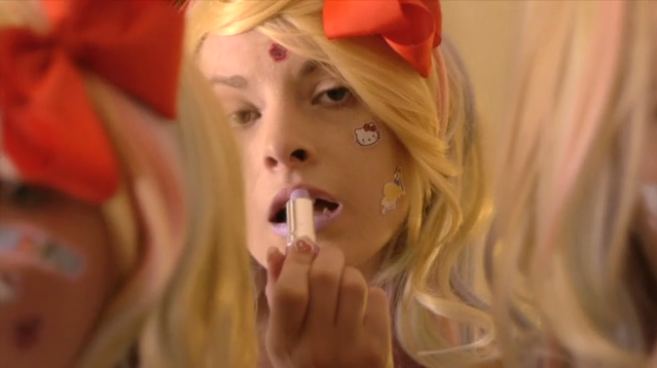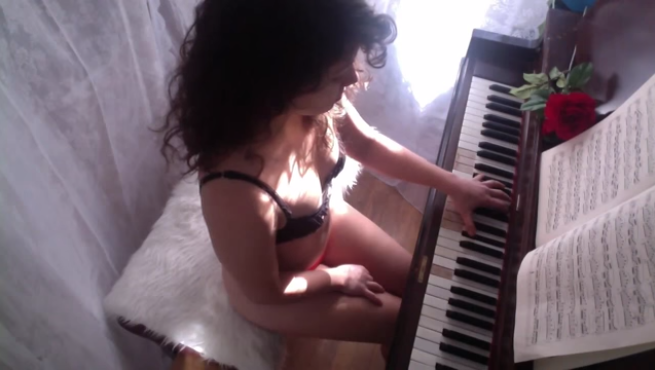
Kate Durbin, HELLO, SELFIE! (2014). Screen capture from performance video filmed by Jessica Nicole Collins.
The online exhibition "Body Anxiety," curated by Jennifer Chan and Leah Schrager, opened Saturday at http://bodyanxiety.com/.
When, in 1991, the first cyberfeminist art group VNS Matrix called themselves "Saboteurs of Big Daddy Mainframe" their bold rhetoric seemed to herald a new feminist revolution. The online exhibition "Body Anxiety," curated by artists Leah Schrager and Jennifer Chan, shows this revolution to be very much a work in progress. More than two decades of cyberfeminism have not been enough to successfully subvert traditional gender roles—not even in its own, online territory.
This is not to say that nothing has changed. The work of young female and gender-queer artists today is more accessible than that of their predecessors, and the desire for change is far more widespread. From Facebook to youtube, tumblr, instagram and beyond, people explore social relations and create their own media identities. In the wake of this, there has been a veritable flood of biographical works and highly vulnerable experiments with popular sexual imagery. Body Anxiety shows a broad selection of these and similar, often subtle, humorous works. The exhibition is not an attack on traditional gender roles, but a call to stay alert to the unrelenting appearance of old and new gender stereotypes in art.
Chan and Schrager pose a sensitive question: why is the work of male artists still valued over that of female artists, even if they cover the same subject matter or work in similar styles and techniques? The curators highlight the issue by showing female artists who use their own bodies as subject matter. Nancy Leticia's video Fantasie Impromptu shows the artist playing a black piano in her underwear. She sits against a white curtain backdrop on a white fluffy pillow. In front of her on the music stand lies a red rose. The scene is utterly kitsch- tooth-enamel-cracking sweet. It is difficult to see this work as "female-empowering." Instead, the artist paints a soft porn stereotype that is at the same time painfully sweet and embarrassingly alluring to watch.

Nancy Leticia, Fantasie Impromptu (2014). Screen capture from video.
Many works in Body Anxiety play with the sexy, sweet girl stereotype in a similar way. Often it is obviously ironic, but at other times, the artist seems incapable of, or even above this form of self-reflection. The critical rant of Angela Washko or the visual power of Hannah Black and Alexandra Marzella stand in stark contrast to the seemingly simple vanity of Erika Alexander, for example. What is interesting about this exhibition is its appeal for recognition of the artistic validity of each position. The time may have come for this to happen. There is a correlation between the self-empowering creation of online diaries, selfies, and other such content (no matter how relative this empowerment may seem), and the battles over territory in gamergate and over gender, race, and cultural diversity in exhibitions.
But by highlighting the specificity of the work of female and gender-queer artists, Chan and Schrager also break the straight white male frame through which most art is still seen and represented. The exhibition itself shows that the selection criteria of art by female and gender-queer artists does not preclude diversity. Next to Letitia's music video there is poetry (Aurorae Parker), drawing (Andrea Crespo), journalism (Rachel Rabbit White), video art (Saoirse Wall, Endam Niham, Ann Hirsch, Georges Jacotey, Hannah Black, Angela Washko, Marie Karlberg), gif art (May Waver, RAFia Santana), digital art (Leah Schrager, Alexandra Marzella), web art (Mary Bond) and online performance (Victoria Campbell, Erika Alexander, Faith Holland, Kate Durbin, Randon Rosenbohm). Possible oddities in my classification aside, it is obvious there is little common ground here besides the subject matter (the problematic view of women's bodies in art and society) and the gender of the artists. This, I think, is another point the curators are trying to make. Body Anxiety is a statement in itself. It is a challenge to keep questioning our views on the work of female and gender-queer artists, even when we think we have already questioned them enough. If, for example, video diaries and selfies of young female artists are being treated as common and meaningless, or less important than larger-scale works, then we haven't.

